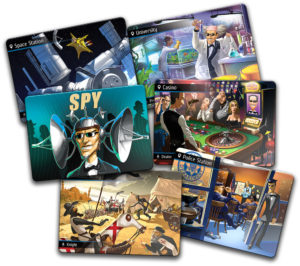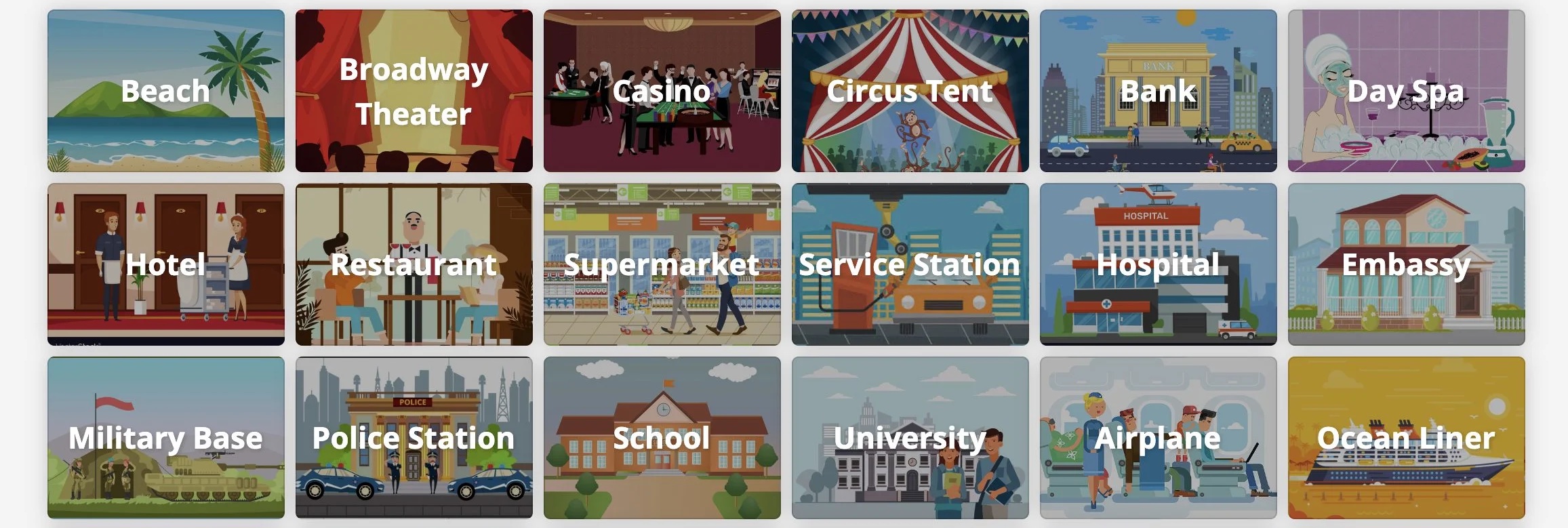For my first critical play, I played Spyfall, a social deduction game created by Alexandr Ushan in 2014. Although Spyfall is originally a card game, I played an online version on netgames.io. The recommended audience for the game is ages 13+, presumably since it requires players to be comfortable with lying and thinking carefully to avoid giving away information.

Formal Elements
Spyfall is a game for 3-8 players (I played with my friends Giulia and Claudia for 3 people total). It’s technically designed as a unilateral competition where the spy plays against the rest of the group, but I think it often felt more like a multilateral competition since it was difficult until later on in the game to tell who the spy was.
At the beginning of the game, each player is randomly assigned one of two roles: they are either a spy or a non-spy. Non-spies are also told the location for the round, which is selected from a list of possible locations including “Airplane”, “Casino”, and “Submarine”, among others.

The objective of the game is to outwit the other players. The spy tries to figure out what the location is without giving away their identity as a spy, while the rest of the group tries to figure out who the spy is without revealing too much information about the location. Gameplay proceeds in the following core loop:
- A player selects another player and asks them a question about the location (for example, “how much time would somebody typically spend in this place?”).
- The other player has to answer the question (ideally in a way that doesn’t reveal that they are the spy / too much information about the location).
- Then, the player who answered the question selects a player to ask a question to, and so forth. (No retaliation questions are allowed to avoid the loophole of only two players asking each other questions over and over.)

One limited resource within the game is time. There is a timer that counts down the amount of time players have left to have each other questions. I assume that this timer depends on the number of players, since for us it was only 3 minutes. Since the game was so short, we played 5 or 6 rounds in total until we felt like we’d had enough.
Other Similar Games
Spyfall is pretty similar in terms of objective to other social deception games like Mafia or Werewolf. I observed two main differences between these other games and Spyfall:
- Firstly, Spyfall only has two roles (as opposed to multiple roles in Werewolf like werewolf, villager, seer, etc.). In my opinion, this made the game a lot easier to explain and understand, which made for a better experience. Trying to explain Werewolf to first-time players can sometimes be frustrating or confusing, which leads to boredom.
- Second, Spyfall only has one spy, whereas Mafia and Werewolf generally involve at least two adversaries. This definitely changes the relationships between players, and I think it can sometimes make it easier for the spy to feel ganged up on in Spyfall since everyone is trying to figure out who they are, whereas they at least have one other ally in games like Mafia or Werewolf.
Overall, I think I liked Spyfall better as a quick game since each round only takes a few minutes, whereas Mafia/Werewolf are more involved. I also think that Spyfall is a better game to play if you have fewer than 6 or 7 people, since it requires a smaller number of players.
Was The Game Fun?
I would say that the game was pretty fun! Even if we weren’t very good, my friends and I got a lot of laughs out of playing it. I especially enjoyed that the roles were a lot simpler than many other games in this genre since you were either a spy or not. I think the rules were overall simpler than many other games, which made the game easier to grasp and enjoy. I also liked that the rounds are short: this made it really easy to play multiple rounds and see ourselves improving at playing the game.
Memorable Moments
Particular Successes
- I think one of the most enjoyable parts of playing the game was actually what happened after: my friends and I engaged in a post-mortem analysis along the lines of “but Claudia said X, so I thought she was the spy!” and “I can’t believe you didn’t realize it was me!”. It was really entertaining to be able to re-visit the game from the other players’ perspective and tease each other about mistakes we made.
- There were also a lot of moments throughout the game that really made us laugh: Claudia gave really vague and generic answers to avoid giving away information, and one time she gave the exact same answer about two different locations (specifically, “Is this a location that people go to regularly?” → “Not all people, but SOME people”), which was hilarious.
Epic Fails
- Honest disclaimer — most of the epic fails during gameplay were caused by me and through no fault of the game itself 🙂
- I’m pretty terrible at lying, so I got caught right away on the first round that we played when I was the spy because I just started laughing! But we re-started the game and thankfully I wasn’t the spy in the next round.
- In one round, my friends mistakenly thought I was the spy because I misinterpreted one of the locations. Specifically, I thought an ocean liner was some sort of military vessel and not a cruise ship (just ESL things), so I answered questions accordingly.
- I also have pretty terrible short-term memory: In one round, the location was the casino and Giulia answered the question “Is this place generally loud?” with “No, not really”. I assumed this meant she was the spy and made a mental note, but by the time it was time to vote, I’d forgotten and voted for Claudia instead (whoops).
Things I Would Change
- I honestly don’t think the game was very fun with just 3 people because it became very easy to figure out who was the spy after a few rounds of questions. Also, because of the no retaliating questions rule, we just had to go around in a circle asking questions to the same person each time, which felt like a frustrating limitation. I think if you’re playing with fewer people, it might make sense to get rid of that rule.
- One variation that I’d like to try is including roleplaying in the game. We played the game moreso along the lines of twenty questions (e.g. “are children welcome in this place?”), but I think a different variation is pretending we’re all people actually in this place, and asking questions such as “what brings you here today?”. I think this added layer of make-believe could make the game more interesting and imaginative.
- I also don’t think the timer added a lot to the game, since people were focused on coming up with quality questions and answers and mostly ignored the timer. It might make more sense to go for a certain number of questions instead.



